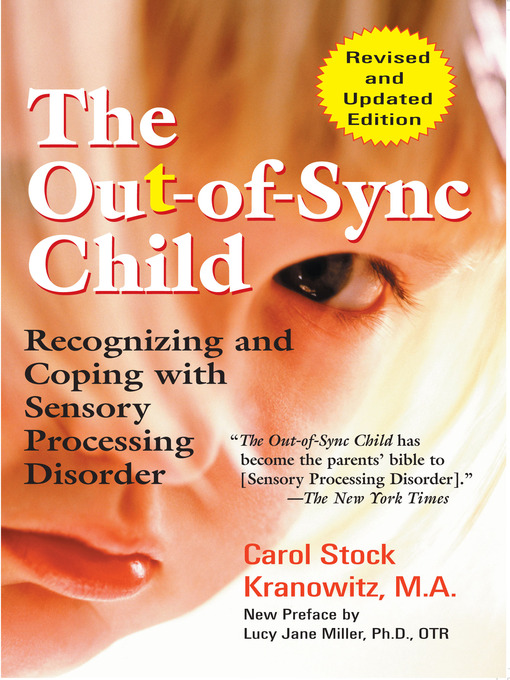Does your child exhibit...
Over-responsivity—or under-responsivity—to touch or movement? A child with SPD may be a "sensory avoider," withdrawing from touch, refusing to wear certain clothing, avoiding active games—or he may be a "sensory disregarder," needing a jump start to get moving.
Over-responsivity—or under-responsivity—to sounds, sights taste, or smell? She may cover her ears or eyes, be a picky eater, or seem oblivious to sensory cues.
Cravings for sensation? The "sensory craver" never gets enough of certain sensations, e.g., messy play, spicy food, noisy action, and perpetual movement.
Poor sensory discrimination? She may not sense the difference between objects or experiences—unaware of what she's holding unless she looks, and unable to sense when she's falling or how to catch herself.
Unusually high or low activity level? The child may be constantly on the go—wearing out everyone around him—or move slowly and tire easily, showing little interest in the world.
Problems with posture or motor coordination? He may slouch, move awkwardly, seem careless or accident-prone.
These are often the first clues to Sensory Processing Disorder—a common but frequently misdiagnosed problem in which the central nervous system misinterprets messages from the senses. The Out-of-Sync Child offers comprehensive, clear information for parents and professionals—and a drug-free treatment approach for children.
This revised edition includes new sections on vision and hearing, picky eaters, and disorders such as autism, among other topics.
-
Creators
-
Series
-
Publisher
-
Release date
April 15, 2009 -
Formats
-
OverDrive Read
- ISBN: 9781101042618
-
EPUB ebook
- ISBN: 9781101042618
- File size: 1680 KB
-
-
Languages
- English
-
Reviews
-
Library Journal
September 1, 2005
Often mistaken for ADHD, Sensory Processing Disorder (SPD), a neurological condition that affects the way the brain absorbs and organizes sensory information, can cause a child to react too much or too little to his or her environment. Depending on which sense is affectedvisual, auditory, tactile, vestibular, or proprioceptivechildren will show a range of different symptoms, though unusual reactions to touching and being touched are the most distinctive. Kranowitz, a preschool teacher with 25 years' experience, helped develop a screening method to identify children with SPD. In this second edition of her book (the first was published in 1998), she describes the many facets and symptoms of SPD and offers new chapters on visual and auditory dysfunctions and updated online resources information. Activities that parents can try at home, strategies that teachers can use in the classroom, and tips on how to cope with an "outofsync" child are also provided. Recent publications on SPD include Lindsay Biel's Raising a Sensory Smart Child. Recommended for all public and academic libraries, especially those that do not own the previous edition.Maryse Breton, Baldwin P.L., Birmingham, MICopyright 2005 Library Journal, LLC Used with permission.
-
Publisher's Weekly
March 2, 1998
Kranowitz, a teacher who has worked for 20 years in the field of sensory integration dysfunction and has developed a screening program for its early identification, writes intelligently about a bewildering topic. Fairly common (an estimated 12%-30% of children are affected), the disorder is nevertheless baffling to experts and parents alike, in part because of its diverse, contradictory symptoms: such children may be either hypo- or hypersensitive. Often erroneously diagnosed with attention deficit disorder (ADD) or labeled "difficult, picky, clumsy, oversensitive, or inattentive," children with SI dysfunction exhibit unusual responses to touching and being touched, and/or to moving and being moved. In concise, well-organized chapters, Kranowitz reveals how the tactile, vestibular (pertaining to gravity and movement) and propriaceptive (pertaining to joints, muscles and ligaments) senses operate. Checklists and sidebars throughout the text compare the "normal" child in various situations to the child with sensory integration dysfunction. Asserting SI dysfunction is best treated by occupational therapy, not by medication, Kranowitz helps clear the way for families to understand a disorder that they may suspect but not have been able to pinpoint.
-
Formats
- OverDrive Read
- EPUB ebook
Languages
- English
Loading
Why is availability limited?
×Availability can change throughout the month based on the library's budget. You can still place a hold on the title, and your hold will be automatically filled as soon as the title is available again.
The Kindle Book format for this title is not supported on:
×Read-along ebook
×The OverDrive Read format of this ebook has professional narration that plays while you read in your browser. Learn more here.


